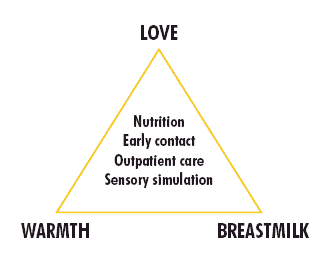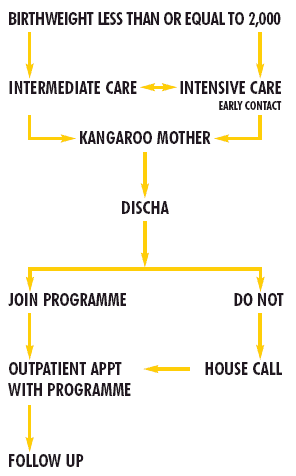The mother kangaroo method
In practice
With the Mother Kangaroo Method, an underweight baby leaves the hospital to go home with his or her mother as soon as possible after birth, upon confirmation that his or her clinical condition is stable. Before leaving the hospital, the mother participates in a process of adaptation and education with respect to the methodology of the programme.
Once home, the mother cares for her baby continuously, in a way similar to that of the baby kangaroo, under her clothing, in contact with her skin. One of the points emphasised most during the adaptation period is that of feeding, which much be done exclusively with breastmilk. Education of the mother, and care for the baby’s health, continues after release from hospital, via outpatient clinic visits.
BASIC ELEMENTS OF THE MOTHER KANGAROO METHOD
•Early return home for babies in good clinical condition, regardless of weight.
•Breast-feeding only as the sole source of nutrition and protection during the first months of life.
•Kangaroo position in order to provide warmth, love, stimulation, ease and security through the mother’s care.
•Education of the mother on caring for her small son or daughter.
•Outpatient care in order to follow the growth and development of the baby and continue the mother’s education.
[p:left]BASIC PRINCIPLES OF THE MOTHER KANGAROO METHOD

The baby is placed against the mother’s breast, with direct skin to skin contact, and in frog position, vertically, in order to avoid regurgitation and bronchial aspiration. There, under the mother’s clothing, the infant must stay 24 hours a day, even when sleeping. The mother should sleep in a semi-seated position. If she needs time for her own personal hygiene or for other reasons, the father, older siblings, or any other member of the family may take the place of the mother. The proximity to the mother – her caresses, her voice, her heartbeat – are considered important factors in the stimulation of the child’s breathing to avoid apneas. The continuous skin-to-skin contact helps the infant maintain adequate body temperature and stimulates the development of a close emotional bond between mother and child. Love, warmth and maternal lactation are the essence of the Mother Kangaroo Method.
CRITERIA FOR ADMITTANCE TO THE OUTPATIENT CLINIC
Generally the programme deals with those infants who weighed less than 2,000 grams upon leaving the hospital, considering that an infant who weighs more does not need to be cared for with the mother kangaroo method.
Mothers of infants who remain hospitalised may enter the newborn care wards several times a day to feed their babies and practice the kangaroo position before the child is released from hospital. The time is used to educate mothers about the importance of breast-feeding, the correct way to maintain the kangaroo position in order to transmit warmth and avoid bronchial aspiration, and to favour a loving relation between mother and child.
Acceptance of babies into the kangaroo programme is handled according to the following flow chart, using as a starting point the infant’s clinical condition and Apgar score at birth.
FLOWCHART FOR ACCEPTANCE INTO MOTHER KANGAROO PROGRAMME

The criteria used for early discharge from hospital involve the mother as much as the infant. The infant’s clinical condition, more than his or her weight, is the determining factor for rapid discharge from hospital. The final physical exam determines the date of release. The mothers should be in good physical condition, and willing to assume responsibility for the special care that her premature son or daughter requires.
When possible, no child is released on Fridays or Saturdays if the outpatient clinic is closed on the weekends. Emergency cases are always attended to, guaranteeing the little ones coverage 24 hours a day, seven days a week.
GENERAL CRITERIA FOR RAPID DISCHARGE FROM HOSPITAL
INFANT
•Absence of: difficulty breathing; infections; neurological problems; metabolic disorders: hypoglycaemia, hypocalcemia, etc.
•Presence of: ability to suck; good response to stimuli; ability to maintain a stable temperature when in the kangaroo position.
•Weight is not a determining factor for release.
MOTHER
•Absence of: infectious diseases; psychological problems.
•Presence of: physical and mental ability to feed and keep her child in the kangaroo position.
•Training in: breast-feeding exclusively; kangaroo position; attention to the infant’s condition; stimulation of the child; regular visits to the outpatient clinic after release.
OUTPATIENT CARE
Following the adaptation period in the newborn care units, the mothers and infants who fit the criteria for leaving the hospital are released and go to the outpatient clinic, preferably the day after leaving the hospital.
The staff that exams the infants in the outpatient clinic comprises paediatric doctors, a qualified nurse, a nurse’s assistant, as well as doctors and nurses in training. The staff encourage and make it possible for the mothers to come to the clinic as many times as necessary during the first weeks and months of life. During the doctor’s visit, the mothers of the smallest premature infants keep their babies in the kangaroo position, underneath their clothing. There the child receives the warmth and stimulation that he or she needs. It is not unusual for another family member, often the father, to be the one to hold the child in the kangaroo position while attending educational talks or awaiting their turn for the baby’s examination. Being together in a group allows the mothers to get to know each other and encourages exchange of experiences for dealing with the babies. A cordial atmosphere is created between the mothers in the programme and the staff who see them, which is very positive and supportive.[/p]
Before beginning the medical check-up, the programme staff (paediatricians, nurses and nutritionists) take advantage of having the mothers together in a group to give brief educational talks which may be complemented with audiovisual aides. Topics covered include those relating to the importance of maternal lactation, the nutritional value of different foods, vaccination, measuring body temperature, infant development and adequate stimulation, and the detection of alarm signals.
Once the educational sessions are over, the nursing staff is in charge of weighing and measuring the height and cephalic diameter of the babies and recording the information on the respective chart. The medical personnel then begin the clinical examination of each child, noting his or her physical condition, weight gain, growth and development, and teaches the mother what to do during outpatient care.
The therapists and psychologists pay special attention to psycho-motor development, using various measuring and evaluation scales. They also work with the mothers in relation to the child’s development, instructing them on adequate stimulation, as well as showing them how to make toys at home that are inexpensive and use different colours in order to help the process of stimulating their children. The mother is shown how to stimulate each of her boy or girl’s five senses.
After the first visit, which is recommended to take place as soon as possible after discharge from hospital, the parents may return as often as they like. The very small babies may and should come every day, and as the baby grows the visits are spread out until they occur at least once a month. There is a telephone number for the mothers to call the clinic when they need to. The staff is very willing to hear any of the problems the mother may have, often dealing with her concerns over the telephone.
Those boys or girls who stay longer in the intensive care units because of their clinical condition may also benefit from direct maternal care, especially being fed with breast milk and developing loving attachment between mother and child.
DOWNLOAD THE BROCHURE PDF
albanian (0.9 MB)spanish (0.6 MB)
english (0.6 MB)
serbian (0.6 MB)








 COUNTRY OF ORIGIN
COUNTRY OF ORIGIN OUTSTANDING IDEASS PROJECTS
OUTSTANDING IDEASS PROJECTS